Design of a Thermoelectric Device for Power Generation through Waste Heat Recovery from Marine Internal Combustion Engines
Abstract
:1. Introduction
2. Background
2.1. Thermoelectric Modules
2.2. Finite Element Method and Solvers
2.3. Latin Hypercube
3. Device and Modeling
3.1. Thermoelectric Device
3.2. Modeling and Analysis
4. Parametric Studies
4.1. Full Factorial
4.2. Latin Hypercube Sampling
5. Conclusions
Author Contributions
Funding
Institutional Review Board Statement
Informed Consent Statement
Acknowledgments
Conflicts of Interest
Appendix A. Parameter Sets for Latin Hypercube Sampling
| Parameter Set # | Fin Thickness [mm] | Number of Fins | Heatsink Height [mm] | Parameter Set # | Fin Thickness [mm] | Number of Fins | Heatsink Height [mm] |
|---|---|---|---|---|---|---|---|
| 1 | 4 | 45 | 50 | 24 | 2 | 55 | 42 |
| 2 | 4 | 45 | 42 | 25 | 2 | 49 | 58 |
| 3 | 2 | 47 | 48 | 26 | 2 | 31 | 24 |
| 4 | 2 | 43 | 40 | 27 | 4 | 31 | 30 |
| 5 | 4 | 37 | 38 | 28 | 4 | 51 | 26 |
| 6 | 2 | 41 | 32 | 29 | 4 | 47 | 36 |
| 7 | 4 | 37 | 44 | 30 | 2 | 45 | 26 |
| 8 | 4 | 39 | 44 | 31 | 2 | 49 | 34 |
| 9 | 2 | 47 | 46 | 32 | 2 | 53 | 58 |
| 10 | 6 | 49 | 44 | 33 | 2 | 41 | 36 |
| 11 | 2 | 45 | 50 | 34 | 4 | 33 | 40 |
| 12 | 2 | 31 | 40 | 35 | 4 | 43 | 28 |
| 13 | 4 | 37 | 34 | 36 | 4 | 37 | 34 |
| 14 | 4 | 35 | 26 | 37 | 2 | 35 | 54 |
| 15 | 2 | 51 | 56 | 38 | 4 | 33 | 48 |
| 16 | 4 | 51 | 28 | 39 | 4 | 43 | 52 |
| 17 | 4 | 47 | 38 | 40 | 6 | 41 | 32 |
| 18 | 2 | 41 | 28 | 41 | 4 | 35 | 58 |
| 19 | 4 | 39 | 30 | 42 | 2 | 51 | 50 |
| 20 | 6 | 33 | 56 | 43 | 4 | 31 | 56 |
| 21 | 6 | 33 | 46 | 44 | 2 | 43 | 36 |
| 22 | 6 | 35 | 54 | 45 | 6 | 39 | 46 |
| 23 | 2 | 49 | 54 | 46 | 2 | 39 | 42 |
References
- Ring, M.J.; Lindner, D.; Cross, E.F.; Schlesinger, M.E. Causes of the global warming observed since the 19th century. Atmospheric Clim. Sci. 2012, 2, 401–415. [Google Scholar] [CrossRef] [Green Version]
- Hegerl, G.C.; Broennimann, S.; Cowan, T.; Friedman, A.R.; Hawkins, E.; Iles, C.E.; Mueller, W.; Schurer, A.; Undorf, S. Causes of climate change over the historical record. Environ. Res. Lett. 2019, 14, 123006. [Google Scholar] [CrossRef]
- International Maritime Organization. Fourth IMO Green House Gas Study; International Maritime Organization: London, UK, 2020. [Google Scholar]
- Kaibe, H.; Makino, K.; Kajihara, T.; Fujimoto, S.; Hachiuma, H. Thermoelectric generating system attached to A carburizing furnace at komatsu Ltd., awazu plant. In AIP Conference Proceedings; American Institute of Physics: College Park, MD, USA, 2012; Volume 1449, p. 524. [Google Scholar]
- Kuroki, T.; Kabeya, K.; Makino, K.; Kajihara, T.; Kaibe, H.; Hachiuma, H.; Matsuno, H.; Fujibayashi, A. Thermoelectric generation using waste heat in steel works. J. Electron. Mater. 2014, 43, 2405–2410. [Google Scholar] [CrossRef]
- Luo, Q.; Li, P.; Cai, L.; Zhou, P.; Tang, D.; Zhai, P.; Zhang, Q. A thermoelectric waste-heat-recovery system for Portland cement rotary kilns. J. Electron. Mater. 2014, 44, 1750–1762. [Google Scholar] [CrossRef]
- Singh, D.V.; Pedersen, E. A review of waste heat recovery technologies for maritime applications. Energy Convers. Manag. 2016, 111, 315–328. [Google Scholar] [CrossRef]
- Kristiansen, N.R.; Snyder, G.J.; Nielsen, H.K.; Rosendahl, L. Waste heat recovery from a marine waste incinerator using a thermoelectric generator. J. Electron. Mater. 2012, 41, 1024–1029. [Google Scholar] [CrossRef] [Green Version]
- Liu, C.; Li, F.; Zhao, C.; Ye, W.; Wang, K.; Dong, Y.; Gao, W. Experimental research of thermal electric power generation from ship incinerator exhaust heat. In IOP Conference Series: Earth and Environmental Science; IOP Publishing: Bristol, UK, 2019; Volume 227, p. 22031. [Google Scholar]
- Kristiansen, N.R.; Nielsen, H.K. Potential for usage of thermoelectric generators on ships. J. Electron. Mater. 2010, 39, 1746–1749. [Google Scholar] [CrossRef] [Green Version]
- Loupis, M.; Papanikolaou, N.; Prousalidis, J. Fuel consumption reduction in marine power systems through thermoelectric energy recovery. In Proceedings of the 2nd International MARINELIVE Conference on All Electric Ship, Athens, Greece, 12–13 February 2014. [Google Scholar]
- Anderson, K.; Brandon, N. Techno-economic analysis of thermoelectrics for waste heat recovery. Energy Sources Part B Econ. Plan. Policy 2019, 14, 147–157. [Google Scholar] [CrossRef]
- Lee, J.; Choo, S.; Ju, H.; Hong, J.; Yang, S.E.; Kim, F.; Gu, D.H.; Jang, J.; Kim, G.; Ahn, S.; et al. Doping-induced viscoelasticity in PbTe thermoelectric inks for 3D printing of power-generating tubes. Adv. Energy Mater. 2021, 11, 2100190. [Google Scholar] [CrossRef]
- Snyder, Χ.G.J.; Toberer, E.S. Complex thermoelectric materials. Nat. Mater. 2008, 2, 105–114. [Google Scholar] [CrossRef]
- TECTEG MFR. Available online: https://thermoelectric-generator.com (accessed on 3 February 2021).
- Pryor, R.W. Multiphysics Modeling Using COMSOL: A First Principles Approach; Jones & Bartlett Learning: Sudbury, MA, USA, 2011; ISBN 978-0763779993. [Google Scholar]
- COMSOL, Inc. COMSOL Multiphysics Version 5.2 User’s Guide; Comsol Inc.: Burlington, MA, USA, 2017. [Google Scholar]
- Schenk, O.; Gärtner, K. Solving unsymmetric sparse systems of linear equations with PARDISO. Future Gener. Comput. Syst. 2004, 20, 475–487. [Google Scholar] [CrossRef]
- Viana, F.A.C. A tutorial on latin hypercube design of experiments. Qual. Reliab. Eng. Int. 2015, 32, 1975–1985. [Google Scholar] [CrossRef]
- Stein, M. Large sample properties of simulations using latin hypercube sampling. Technometrics 1987, 29, 143. [Google Scholar] [CrossRef]
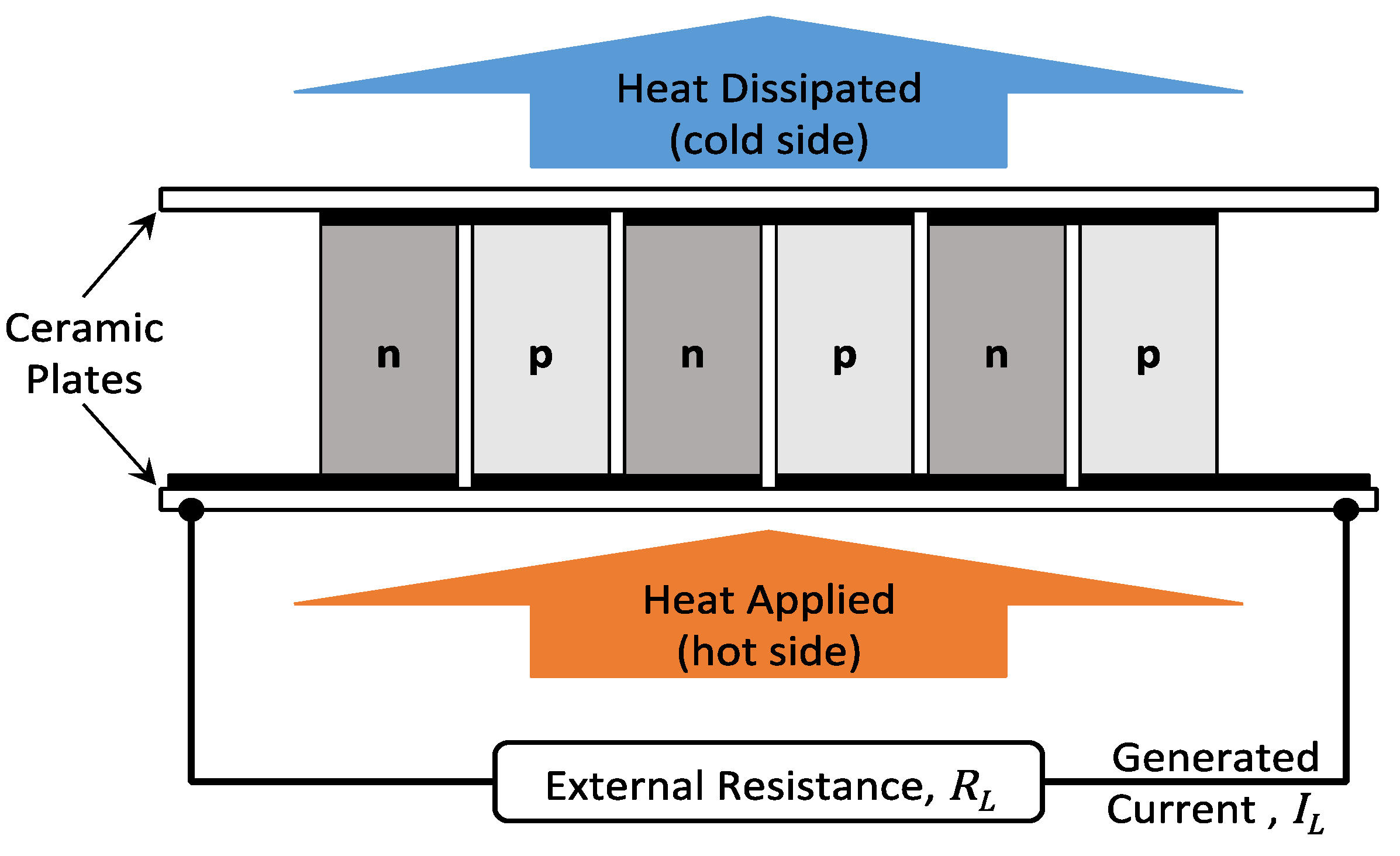
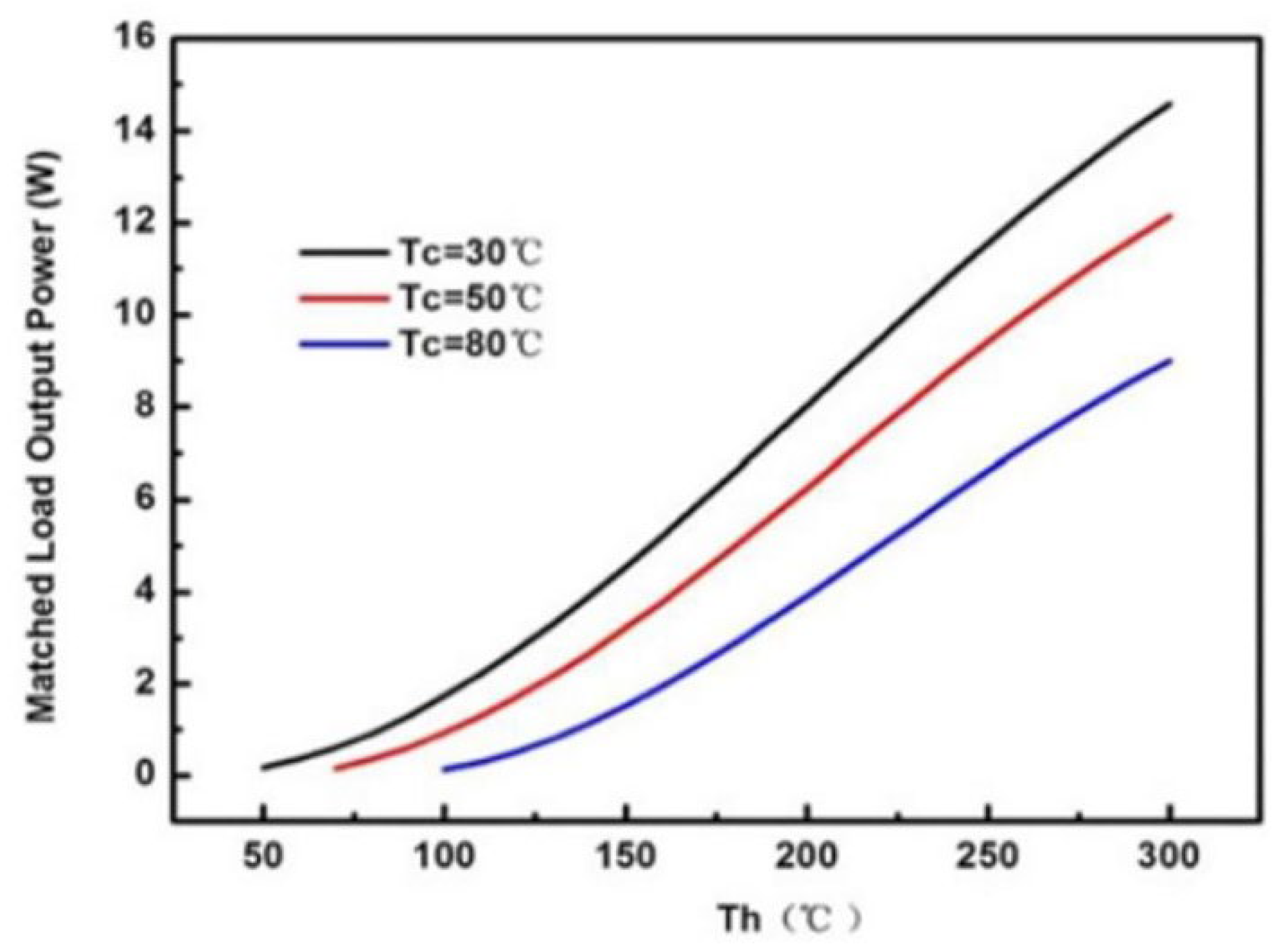
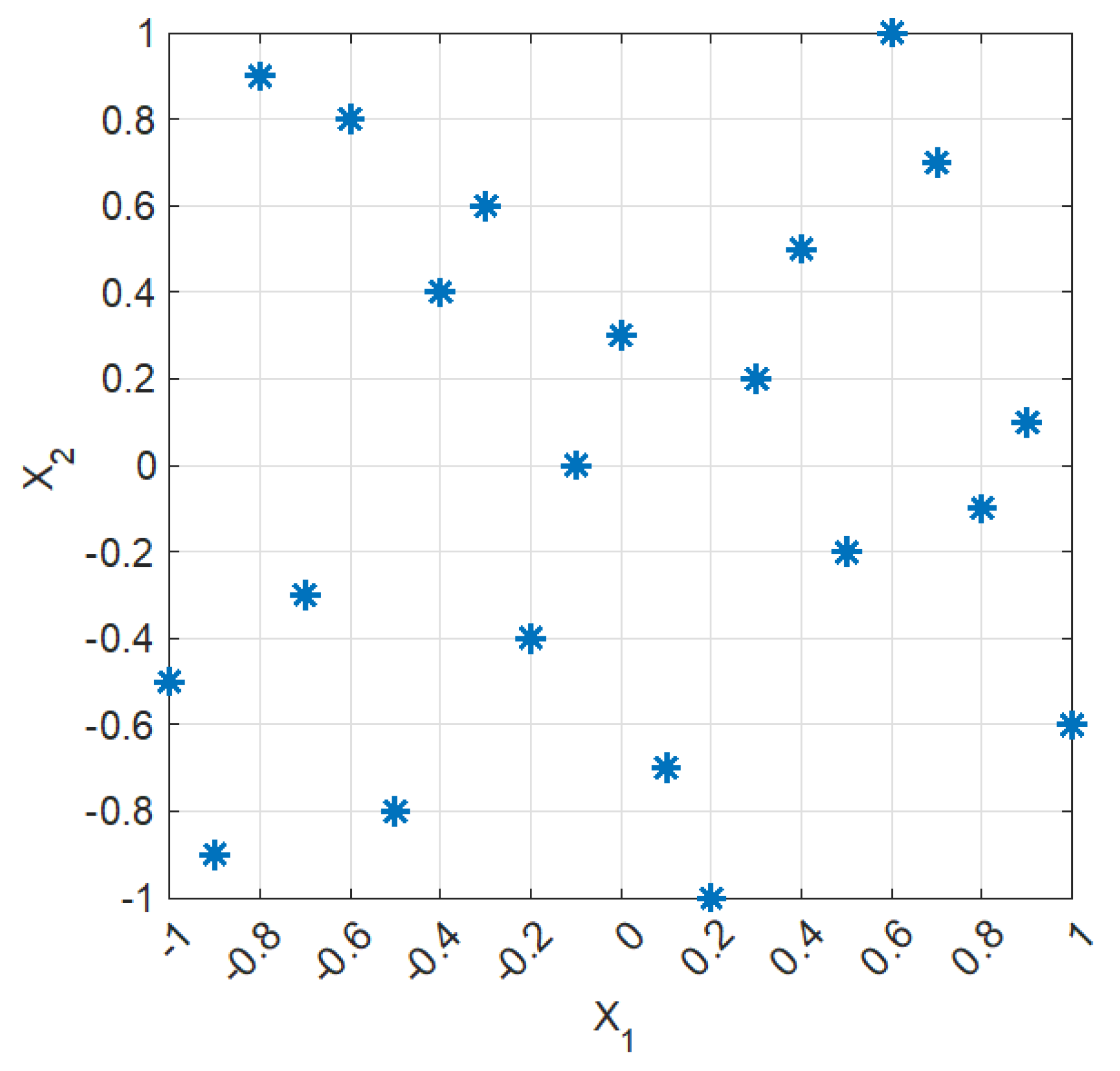
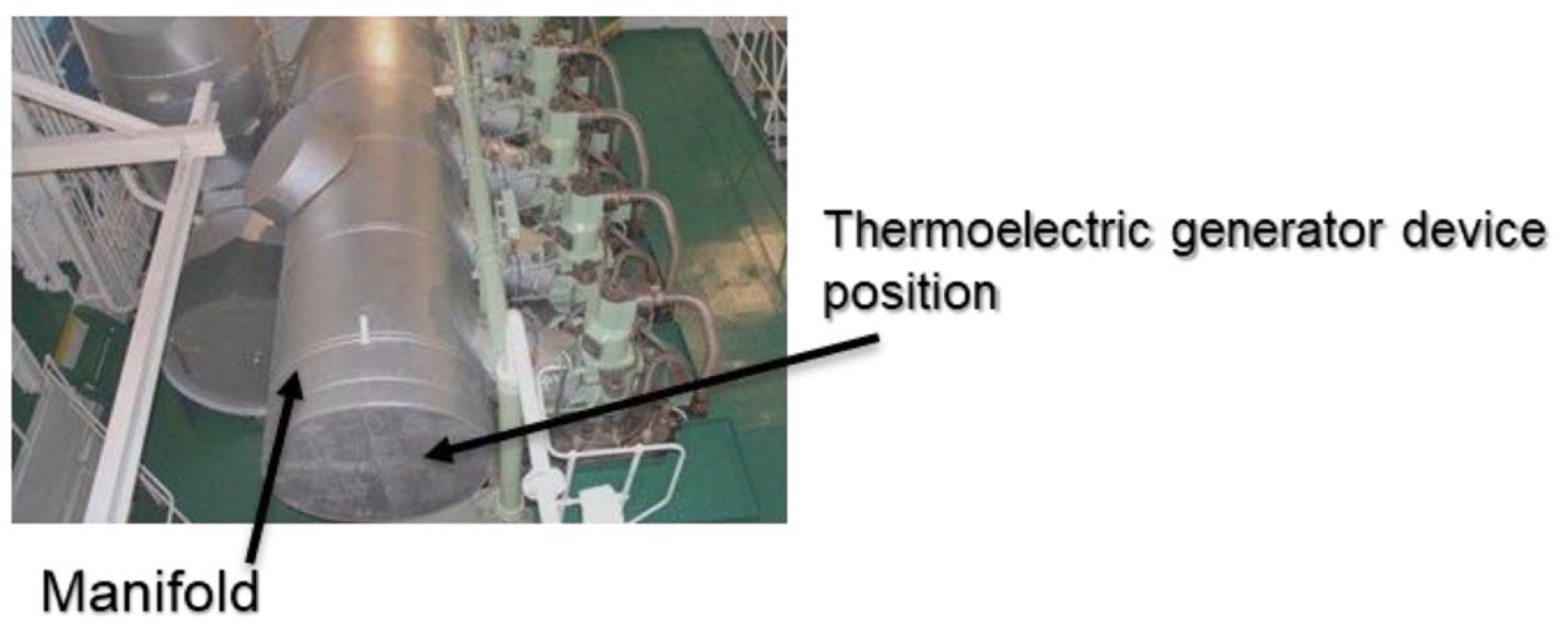
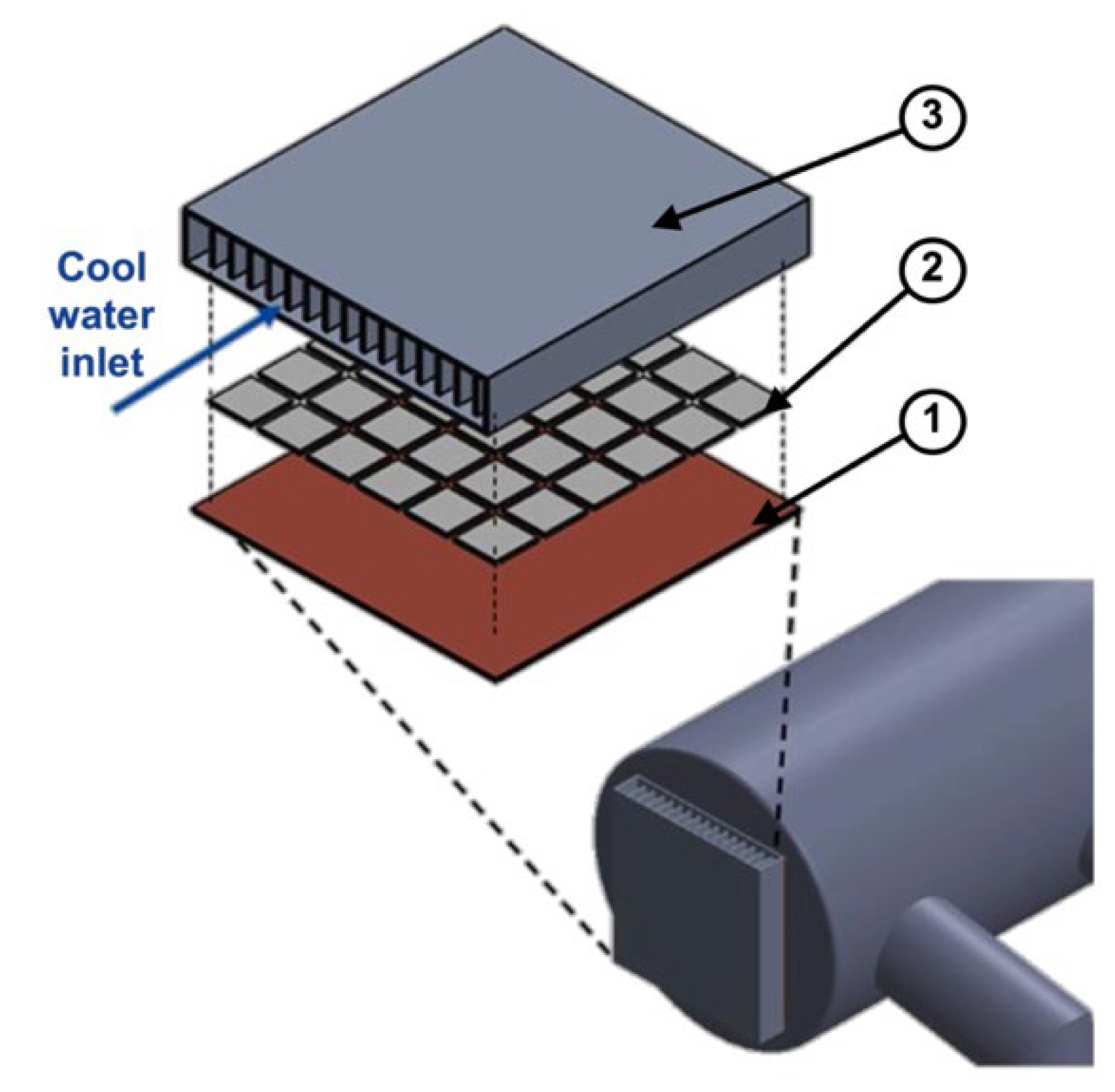
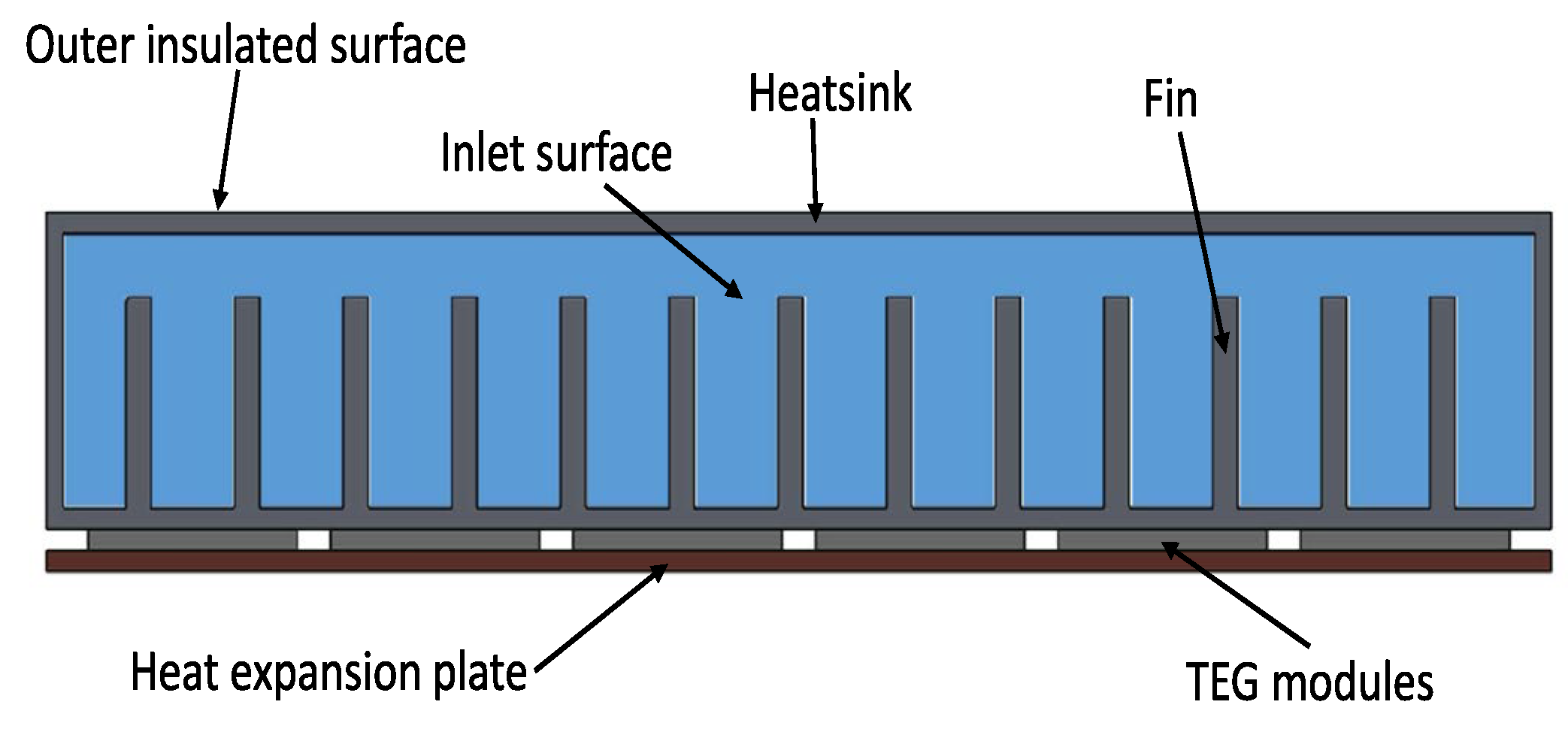
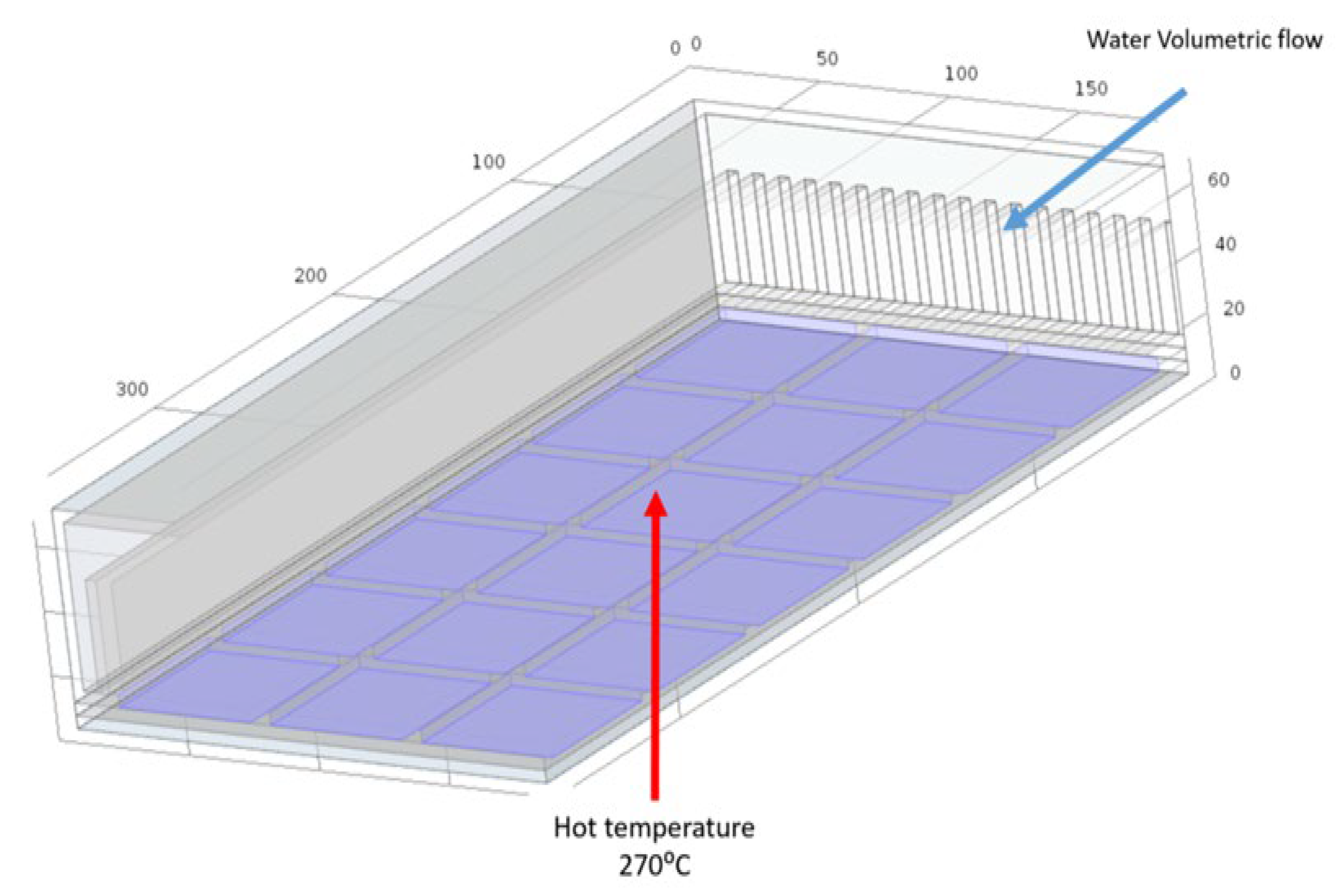
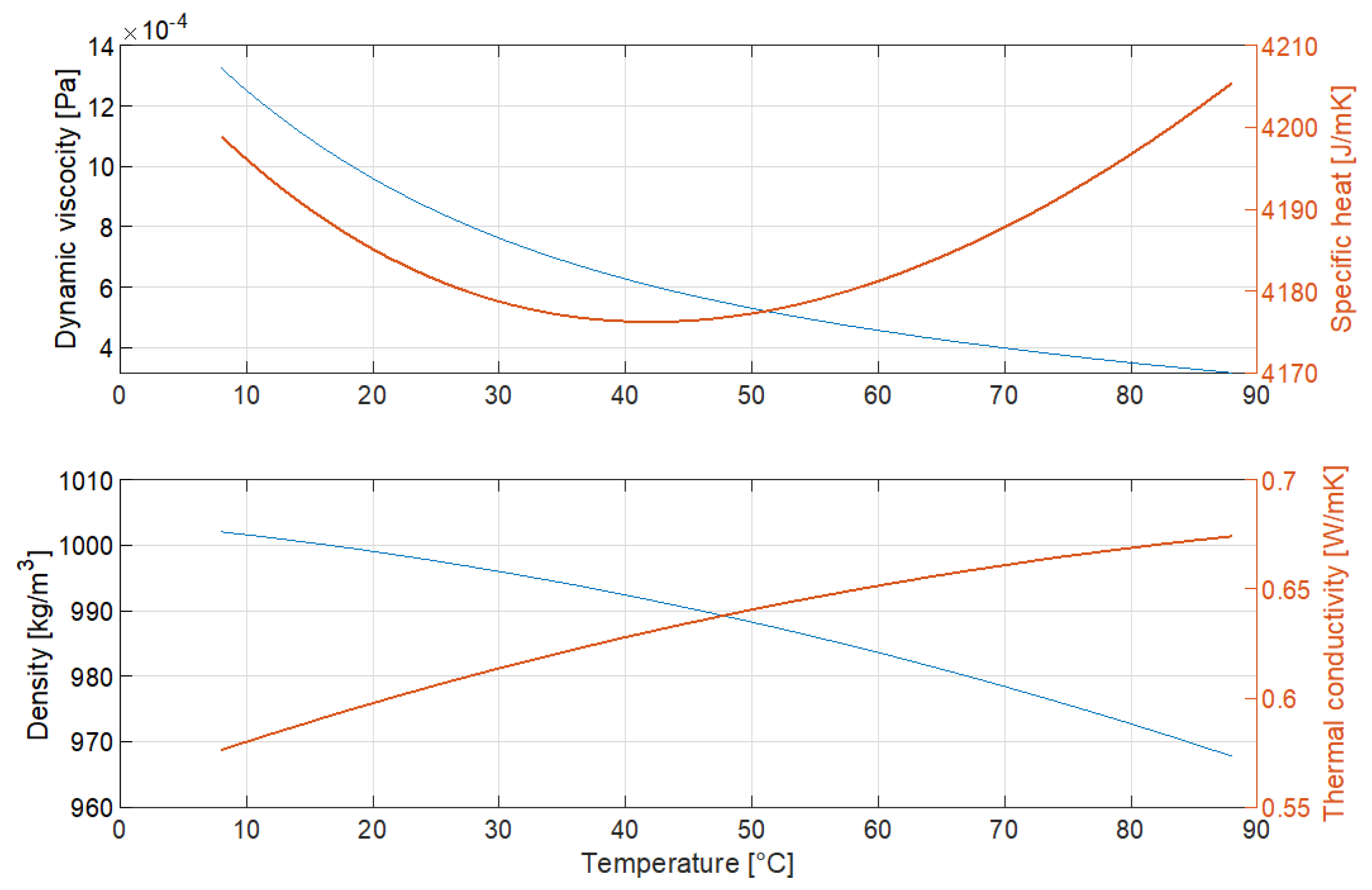
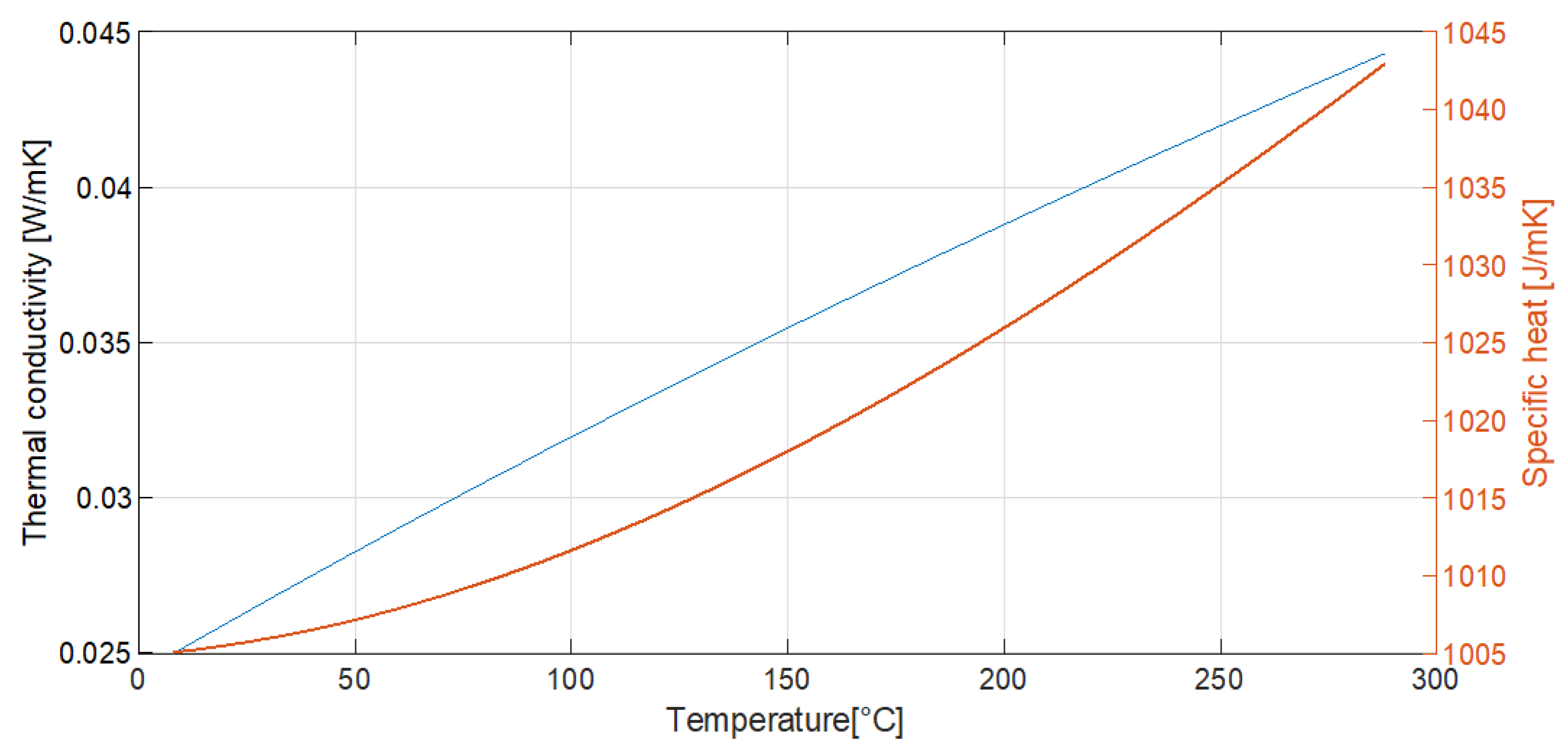

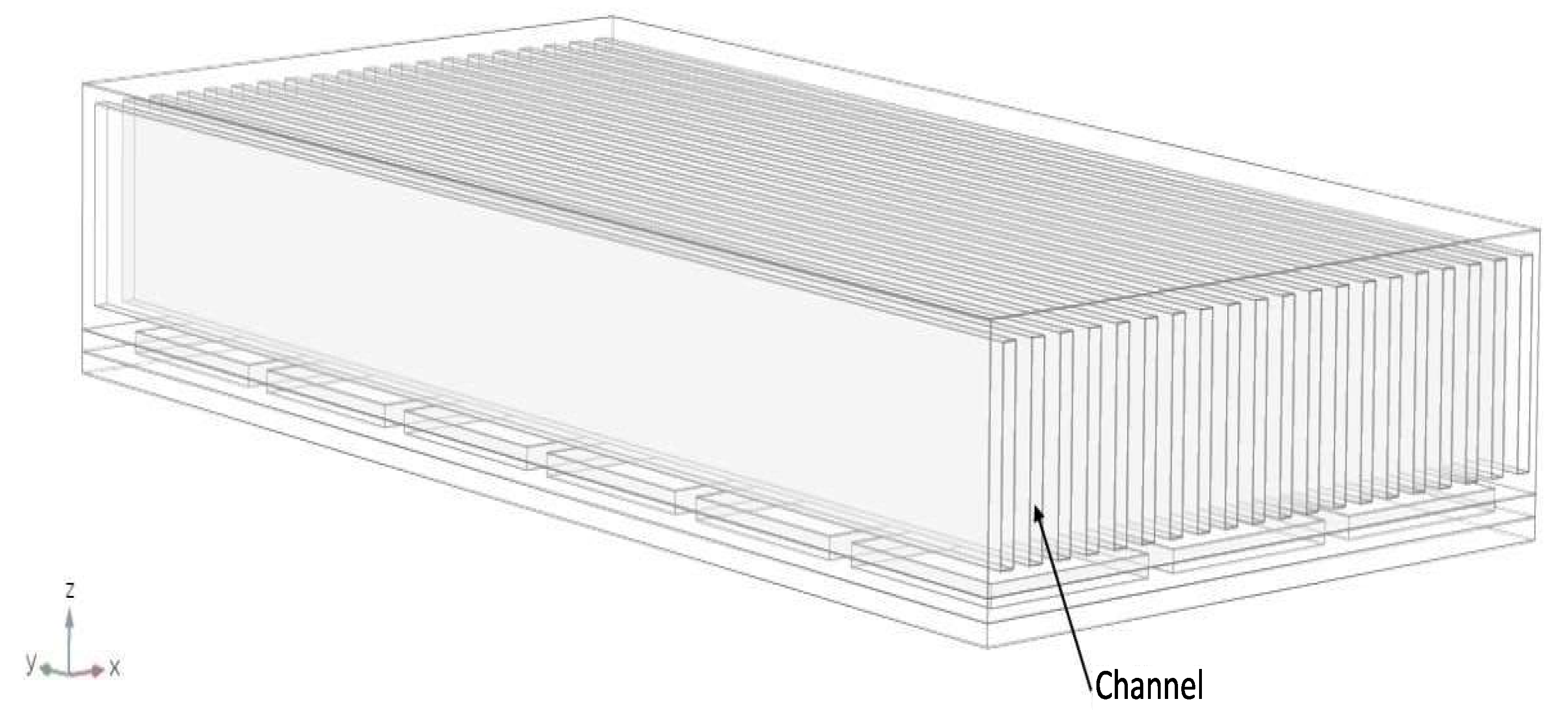


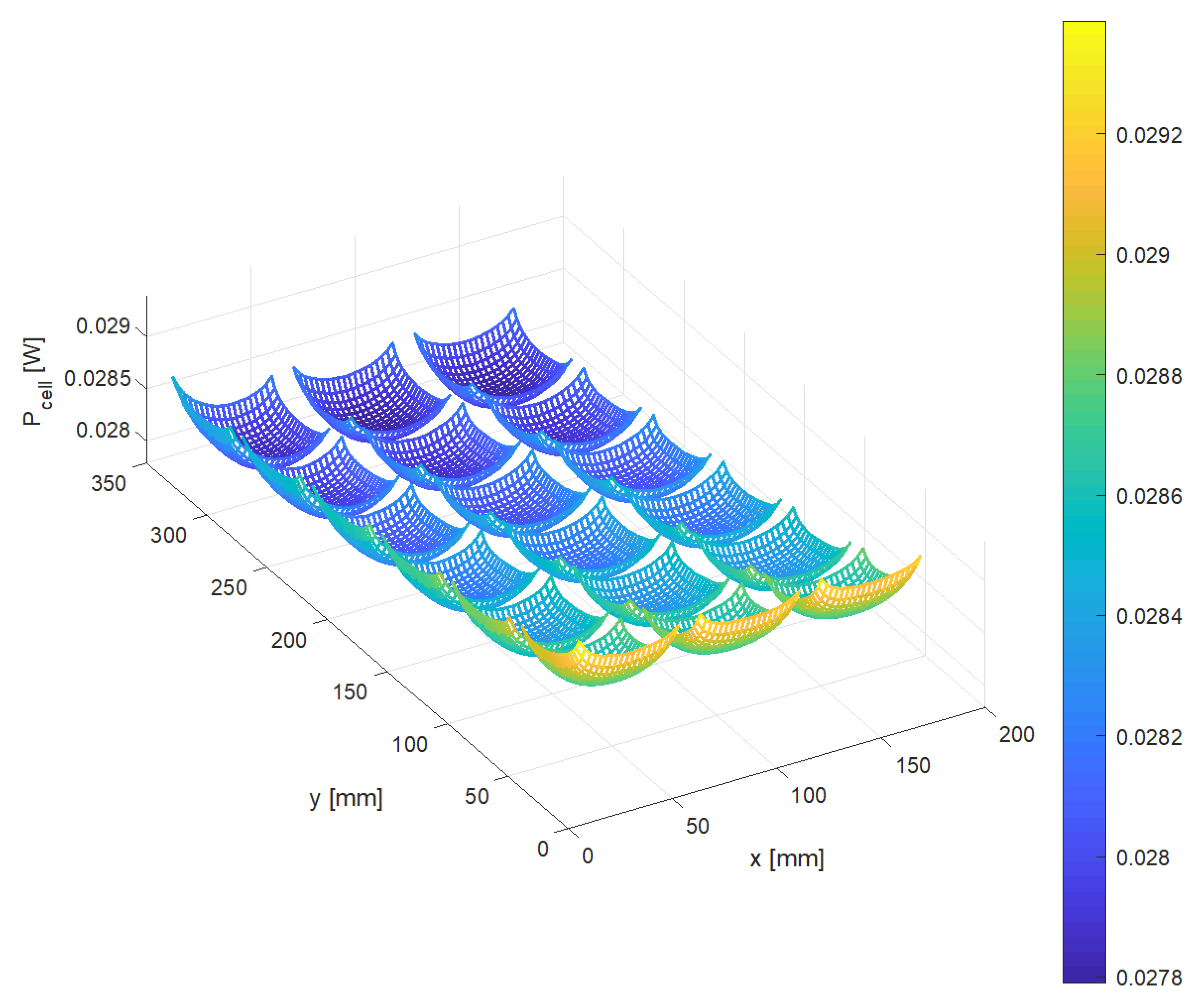
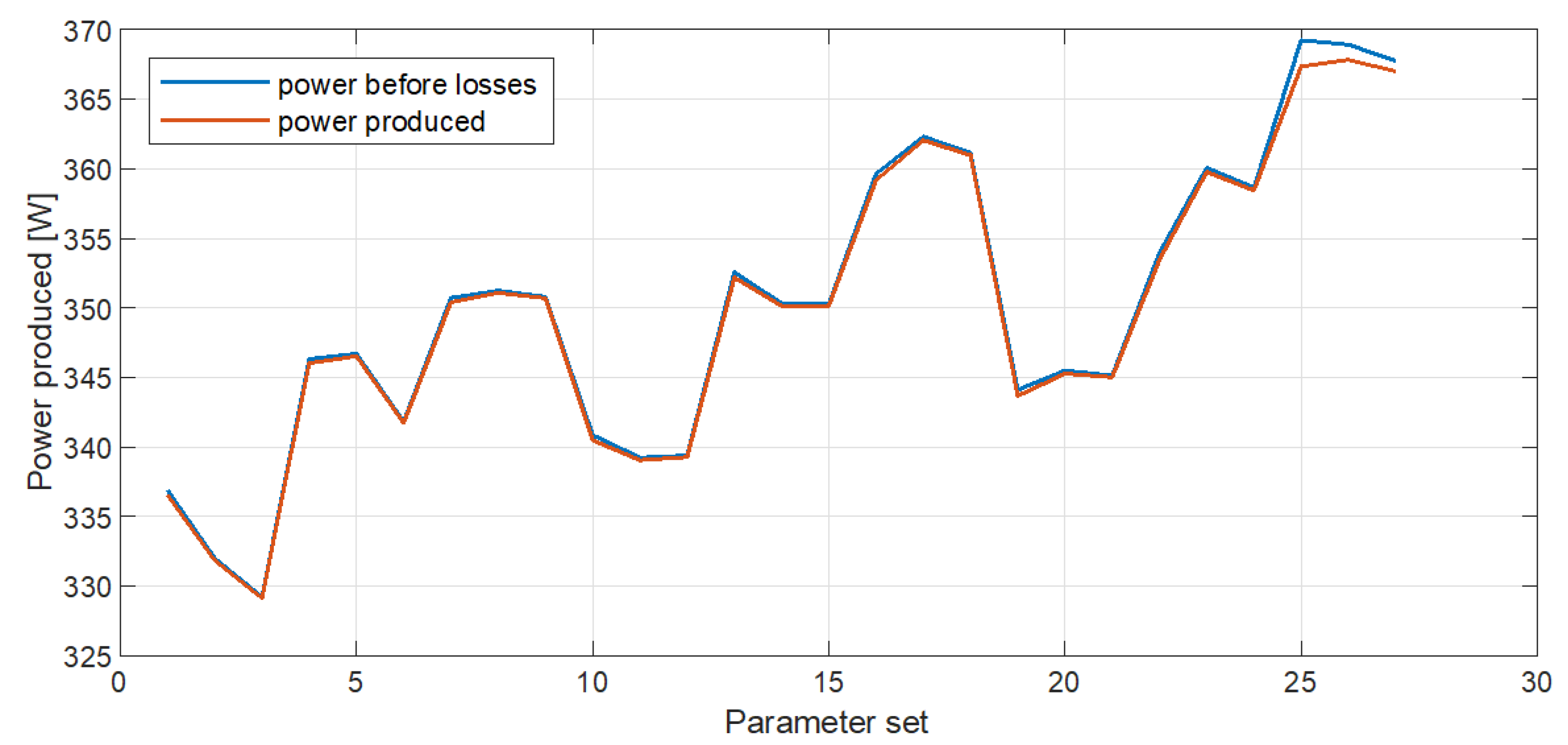

| Parameter | Value |
|---|---|
| Thermal conductivity k [W/mK] | 1.2 |
| Density ρ [kg/m3] | 7700 |
| Specific heat Cp [J/kgK] | 154 |
| Material Property | Aluminum | Cooper |
|---|---|---|
| Thermal conductivity k [W/mK] | 238 | 400 |
| Density ρ [kg/m3] | 2700 | 8960 |
| Specific heat Cp [J/kgK] | 900 | 385 |
| Parameter | Calculation Formula | Description |
|---|---|---|
| h_heatsink | 60 [mm] | Heatsink height |
| t_fin | 4 [mm] | Fin thickness |
| n_size | 30 | Number of fins |
| h_fin | h_heatsink-8 [mm] | Fin height |
| t_chan | (352 − n_size × t_fin)/(n_size + 1) [mm] | Channel thickness |
| Entry_area | (t_vent × (n_size + 1) × h_fin) [mm2] | Inlet area |
| Q_entry | 0.0004 [m3/s] | Volumetric flow |
| v_entry | Q_entry/Entry_area [m/s] | Water velocity |
| Parameter | Value |
|---|---|
| Fin thickness | 3, 5, 7 [mm] |
| Heatsink height | 30, 45, 60 [mm] |
| Number of fins | 23, 33, 43 |
Publisher’s Note: MDPI stays neutral with regard to jurisdictional claims in published maps and institutional affiliations. |
© 2022 by the authors. Licensee MDPI, Basel, Switzerland. This article is an open access article distributed under the terms and conditions of the Creative Commons Attribution (CC BY) license (https://creativecommons.org/licenses/by/4.0/).
Share and Cite
Konstantinou, G.; Kyratsi, T.; Louca, L.S. Design of a Thermoelectric Device for Power Generation through Waste Heat Recovery from Marine Internal Combustion Engines. Energies 2022, 15, 4075. https://doi.org/10.3390/en15114075
Konstantinou G, Kyratsi T, Louca LS. Design of a Thermoelectric Device for Power Generation through Waste Heat Recovery from Marine Internal Combustion Engines. Energies. 2022; 15(11):4075. https://doi.org/10.3390/en15114075
Chicago/Turabian StyleKonstantinou, Georgios, Theodora Kyratsi, and Loucas S. Louca. 2022. "Design of a Thermoelectric Device for Power Generation through Waste Heat Recovery from Marine Internal Combustion Engines" Energies 15, no. 11: 4075. https://doi.org/10.3390/en15114075







